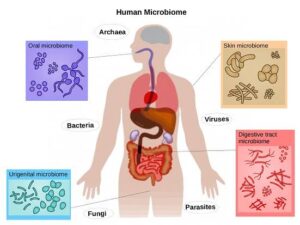Back to: MICROBIOLOGY 300 LEVEL
Welcome to class!
You’re very welcome once again. It’s always a pleasure having you here. You’re steadily building a solid foundation in microbiology, and today’s lesson is one that will truly help you see the human body in a new light. We’re discussing Normal Flora and Opportunistic Infections—an important topic that shows us how not all microbes are harmful, and how even the good ones can sometimes cause trouble.
Normal Flora And Opportunistic Infections
What is Normal Flora?
Let’s begin with something many people don’t realise: your body is not just made of human cells. All over your skin, inside your mouth, intestines, and other body parts, there are millions of microorganisms living peacefully with you. These microorganisms are called normal flora, also known as commensals or microbiota.

They are part of a healthy body and begin to develop from the moment you are born. For instance, as a baby passes through the birth canal or drinks breast milk, it starts collecting friendly microbes. These microbes do not cause disease under normal conditions. Instead, they help us in many ways—breaking down food, producing vitamins, protecting against harmful organisms, and even supporting the immune system.
Examples of Normal Flora
Skin – Staphylococcus epidermidis, Corynebacterium species
Mouth and throat – Streptococcus species, Lactobacillus
Intestines – Escherichia coli, Bacteroides, Lactobacillus
Vagina – Lactobacillus species, which help maintain an acidic environment to prevent infections
Think of them like friendly tenants in a compound—they help clean up, maintain peace, and keep the gate locked against invaders.
What are Opportunistic Infections?
Even though normal flora are generally helpful, they can become dangerous when certain conditions change. This is where opportunistic infections come in. These are infections caused by organisms that are normally harmless but take advantage of a weakened immune system or an unusual situation in the body.
For example, imagine a security man in a peaceful estate suddenly turning into a thief during a blackout. That’s similar to what happens when normal flora take the opportunity to cause disease.
Conditions That Lead to Opportunistic Infections
Weakened immunity – For instance, in people living with HIV/AIDS or undergoing chemotherapy.

Antibiotic misuse – Antibiotics can kill normal flora, creating space for resistant or harmful microbes to take over.
Injury or surgery – If normal flora from the skin enter a surgical wound, they can cause infection.
Changes in environment – For example, excessive washing with antiseptics may disturb the balance of skin flora.
A common example is Candida albicans, a fungus that lives harmlessly in the mouth or vagina but can cause thrush or yeast infections when the immune system is down or antibiotics kill competing bacteria.
Importance of Normal Flora
They compete with pathogens for space and nutrients, reducing the chances of infection.
They help train and strengthen the immune system.

In the gut, they aid in digestion and vitamin production, especially vitamins K and B12.
However, once their balance is disturbed or they enter parts of the body they don’t belong to, trouble may begin.
Summary
- Normal flora are microorganisms that naturally live in and on the human body without causing disease under normal conditions.
- Opportunistic infections occur when these normally harmless microbes take advantage of weakened immunity or other changes in the body.
- Maintaining a healthy balance of normal flora is vital for overall health.
Evaluation
- Define normal flora and list two examples from different parts of the body.
- What is an opportunistic infection? Give one example.
- List three conditions that can lead to an opportunistic infection.
Understanding how our relationship with microbes works is a big step in becoming a skilled microbiologist. Keep learning and keep growing. You’re developing the kind of knowledge that will help change lives, right here in Nigeria and across the world. Afrilearn is proud to walk this journey with you. See you in the next class!
